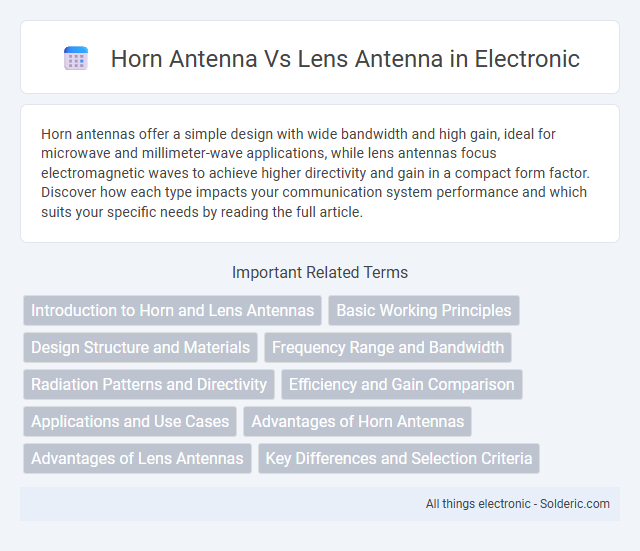Horn antennas offer a simple design with wide bandwidth and high gain, ideal for microwave and millimeter-wave applications, while lens antennas focus electromagnetic waves to achieve higher directivity and gain in a compact form factor. Discover how each type impacts your communication system performance and which suits your specific needs by reading the full article.
Comparison Table
| Feature | Horn Antenna | Lens Antenna |
|---|---|---|
| Design | Flared waveguide horn | Dielectric lens attached to a feed antenna |
| Gain | Moderate (typically 10-25 dBi) | High (up to 40 dBi or more) |
| Beamwidth | Wide to moderate (depends on horn size) | Narrow and highly focused |
| Frequency Range | Microwave and millimeter-wave bands (GHz range) | Microwave to millimeter-wave bands (GHz range) |
| Efficiency | High | Very high, depends on lens material |
| Size & Weight | Relatively compact and lightweight | Bulky and heavier due to lens |
| Cost | Low to moderate | Higher, due to lens fabrication |
| Application | Satellite communication, radar feeds | High-gain systems, point-to-point links |
Introduction to Horn and Lens Antennas
Horn antennas, commonly used for microwave frequencies, provide a directional radiation pattern with moderate gain by flaring a waveguide into a conical or pyramidal shape, ideal for precise signal transmission and reception. Lens antennas utilize dielectric materials to focus electromagnetic waves, enhancing gain and directivity by refracting microwaves similarly to optical lenses, making them suitable for satellite communication and radar systems. Your choice depends on the application's need for bandwidth, gain, and physical size, with horn antennas offering simplicity and lens antennas delivering higher gain and sharper beam control.
Basic Working Principles
Horn antennas operate by directing radio waves through a flared metal waveguide, effectively radiating or receiving electromagnetic energy with a focused beam. Lens antennas utilize dielectric materials to refract and concentrate electromagnetic waves, similar to optical lenses focusing light, thereby enhancing gain and directivity. Both antennas transform wavefronts for improved signal propagation, but horn antennas rely on physical waveguide shaping, whereas lens antennas depend on material-induced refraction.
Design Structure and Materials
Horn antennas feature a flared metal waveguide design typically fabricated from aluminum or copper, providing a simple structure that efficiently directs radio waves with low loss. Lens antennas incorporate dielectric materials such as Teflon, polyethylene, or polystyrene, shaping the wavefront through lenses made from these low-loss materials to focus or collimate the signal. The horn antenna's metal structure offers robustness and ease of manufacturing, while lens antennas demand precision in dielectric material selection and geometry to achieve optimal focusing characteristics.
Frequency Range and Bandwidth
Horn antennas typically operate efficiently within the microwave frequency range of 1 GHz to 40 GHz, offering moderate bandwidth suitable for radar and satellite communications. Lens antennas, designed to focus and collimate waves, can cover similar high-frequency ranges but excel in providing wider bandwidth with improved gain and directivity at millimeter-wave frequencies above 30 GHz. Your choice between horn and lens antennas should consider the specific frequency range and bandwidth requirements of your application to optimize performance.
Radiation Patterns and Directivity
Horn antennas exhibit a well-defined main radiation lobe with moderate side lobes, providing stable and predictable radiation patterns ideal for applications requiring wide bandwidth and medium directivity. Lens antennas, equipped with dielectric materials, focus electromagnetic waves to achieve higher directivity and narrower beamwidths, making them suitable for long-distance communication where precision is critical. Your choice between these antennas depends on whether you prioritize broader coverage with uniform gain or highly focused energy transmission.
Efficiency and Gain Comparison
Horn antennas typically offer moderate gain ranging from 10 to 25 dBi with high efficiency around 70-90%, making them suitable for wideband applications. Lens antennas can achieve higher gain values exceeding 30 dBi and maintain efficiency above 85%, owing to their ability to focus electromagnetic waves more precisely. The choice between the two depends on the required beamwidth and frequency range, with lens antennas excelling in high-gain, narrow-beam scenarios and horn antennas favored for broadband efficiency.
Applications and Use Cases
Horn antennas are widely used in satellite communication, radar systems, and microwave testing due to their high directivity and ease of fabrication. Lens antennas excel in applications requiring beam shaping and focusing, such as in radio astronomy, point-to-point communication links, and advanced radar systems where precise signal control is crucial. You can choose a horn antenna for robust, cost-effective setups or a lens antenna for enhanced performance in complex, high-frequency environments.
Advantages of Horn Antennas
Horn antennas offer a wide bandwidth, high gain, and excellent radiation efficiency, making them ideal for microwave and radio frequency applications. Their simple design provides easy fabrication and low cost compared to lens antennas, which require complex lenses and materials. You benefit from the horn antenna's superior directivity and low side lobes, ensuring precise signal transmission and reception in various communication systems.
Advantages of Lens Antennas
Lens antennas offer superior beam focusing and high gain compared to horn antennas, making them ideal for applications requiring precise signal directionality. Their ability to shape electromagnetic waves reduces side lobes and enhances overall antenna efficiency. Lens antennas are particularly advantageous in high-frequency millimeter-wave communication systems due to their compact size and improved bandwidth performance.
Key Differences and Selection Criteria
Horn antennas provide broad bandwidth and moderate gain, making them ideal for applications requiring wide frequency ranges and ease of manufacturing. Lens antennas offer higher gain and narrow beamwidth, suitable for long-distance communication and high-resolution radar systems. Selection criteria depend on required gain, beamwidth, frequency range, size constraints, and application-specific performance needs.
horn antenna vs lens antenna Infographic

 solderic.com
solderic.com